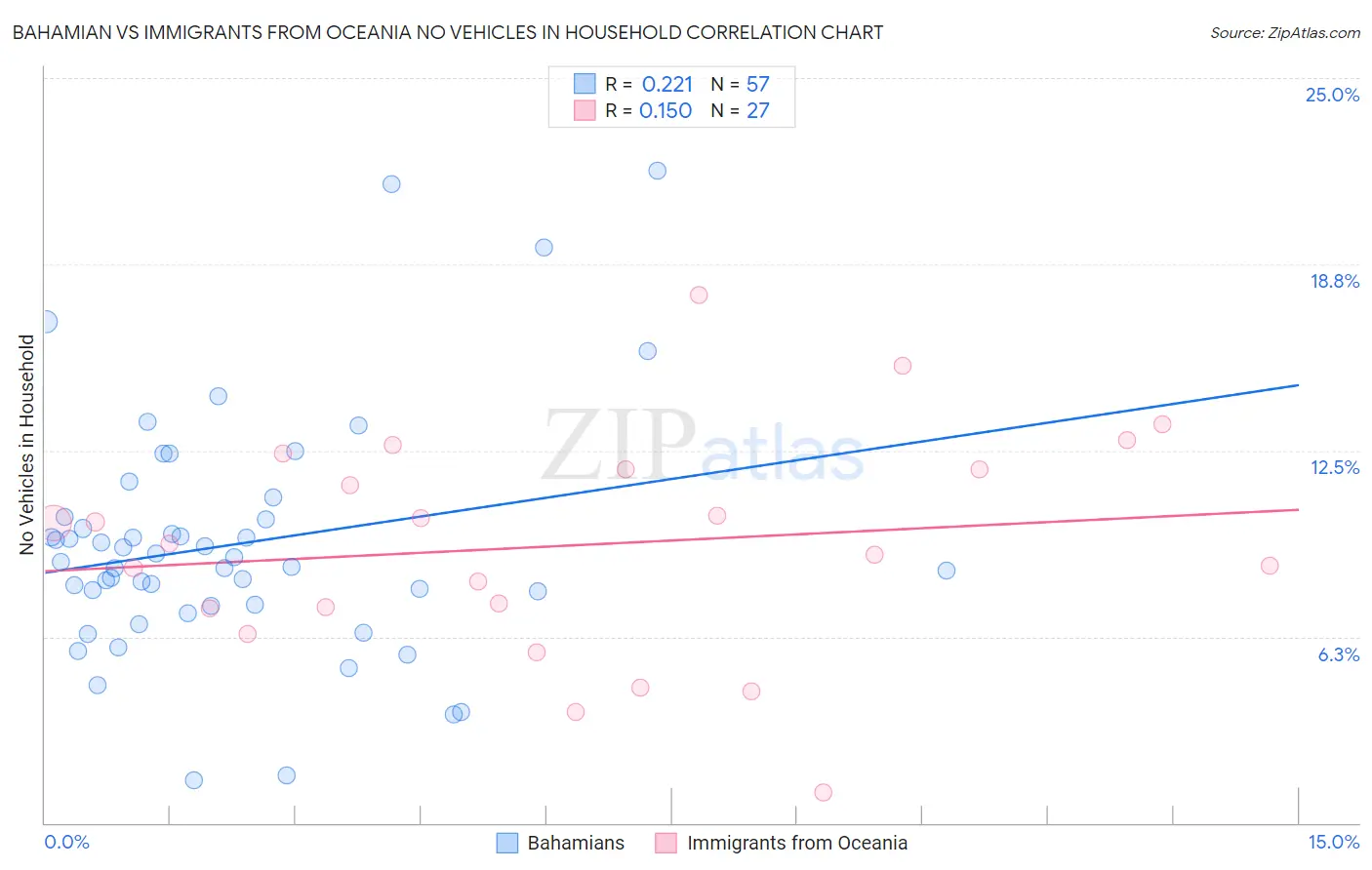Bahamian vs Immigrants from Oceania No Vehicles in Household
COMPARE
Bahamian
Immigrants from Oceania
No Vehicles in Household
No Vehicles in Household Comparison
Bahamians
Immigrants from Oceania
9.9%
NO VEHICLES IN HOUSEHOLD
81.0/ 100
METRIC RATING
145th/ 347
METRIC RANK
9.7%
NO VEHICLES IN HOUSEHOLD
87.1/ 100
METRIC RATING
133rd/ 347
METRIC RANK
Bahamian vs Immigrants from Oceania No Vehicles in Household Correlation Chart
The statistical analysis conducted on geographies consisting of 112,549,845 people shows a weak positive correlation between the proportion of Bahamians and percentage of households with no vehicle available in the United States with a correlation coefficient (R) of 0.221 and weighted average of 9.9%. Similarly, the statistical analysis conducted on geographies consisting of 304,786,769 people shows a poor positive correlation between the proportion of Immigrants from Oceania and percentage of households with no vehicle available in the United States with a correlation coefficient (R) of 0.150 and weighted average of 9.7%, a difference of 1.7%.

No Vehicles in Household Correlation Summary
| Measurement | Bahamian | Immigrants from Oceania |
| Minimum | 1.4% | 1.0% |
| Maximum | 21.9% | 17.7% |
| Range | 20.5% | 16.7% |
| Mean | 9.3% | 9.3% |
| Median | 8.7% | 9.4% |
| Interquartile 25% (IQ1) | 7.3% | 7.2% |
| Interquartile 75% (IQ3) | 10.2% | 11.9% |
| Interquartile Range (IQR) | 2.9% | 4.7% |
| Standard Deviation (Sample) | 4.1% | 3.7% |
| Standard Deviation (Population) | 4.0% | 3.6% |
Demographics Similar to Bahamians and Immigrants from Oceania by No Vehicles in Household
In terms of no vehicles in household, the demographic groups most similar to Bahamians are Chilean (9.9%, a difference of 0.030%), Immigrants from Bahamas (9.9%, a difference of 0.030%), Hungarian (9.9%, a difference of 0.23%), Immigrants from Nicaragua (9.9%, a difference of 0.28%), and Immigrants from Zimbabwe (9.9%, a difference of 0.38%). Similarly, the demographic groups most similar to Immigrants from Oceania are Syrian (9.7%, a difference of 0.020%), Kenyan (9.7%, a difference of 0.30%), Immigrants from the Azores (9.7%, a difference of 0.37%), Burmese (9.7%, a difference of 0.58%), and Latvian (9.8%, a difference of 0.60%).
| Demographics | Rating | Rank | No Vehicles in Household |
| Nicaraguans | 89.5 /100 | #129 | Excellent 9.7% |
| Burmese | 88.8 /100 | #130 | Excellent 9.7% |
| Immigrants | Azores | 88.2 /100 | #131 | Excellent 9.7% |
| Kenyans | 88.0 /100 | #132 | Excellent 9.7% |
| Immigrants | Oceania | 87.1 /100 | #133 | Excellent 9.7% |
| Syrians | 87.1 /100 | #134 | Excellent 9.7% |
| Latvians | 85.1 /100 | #135 | Excellent 9.8% |
| Immigrants | South Africa | 85.0 /100 | #136 | Excellent 9.8% |
| Immigrants | Moldova | 84.6 /100 | #137 | Excellent 9.8% |
| Estonians | 84.2 /100 | #138 | Excellent 9.8% |
| Marshallese | 84.0 /100 | #139 | Excellent 9.8% |
| Immigrants | Lithuania | 84.0 /100 | #140 | Excellent 9.8% |
| Sudanese | 83.1 /100 | #141 | Excellent 9.8% |
| Immigrants | Zimbabwe | 82.6 /100 | #142 | Excellent 9.9% |
| Chileans | 81.2 /100 | #143 | Excellent 9.9% |
| Immigrants | Bahamas | 81.2 /100 | #144 | Excellent 9.9% |
| Bahamians | 81.0 /100 | #145 | Excellent 9.9% |
| Hungarians | 80.0 /100 | #146 | Excellent 9.9% |
| Immigrants | Nicaragua | 79.8 /100 | #147 | Good 9.9% |
| Immigrants | Bosnia and Herzegovina | 79.1 /100 | #148 | Good 9.9% |
| Immigrants | Uganda | 76.1 /100 | #149 | Good 10.0% |